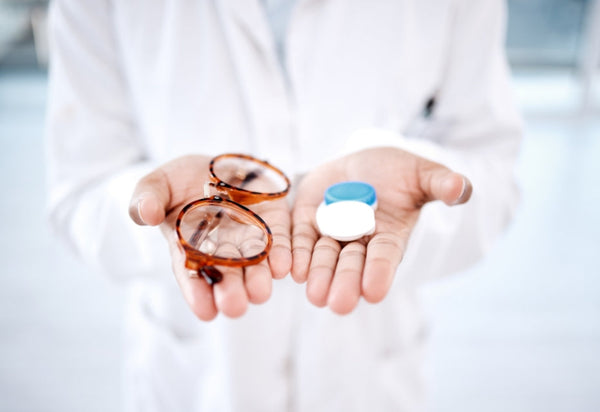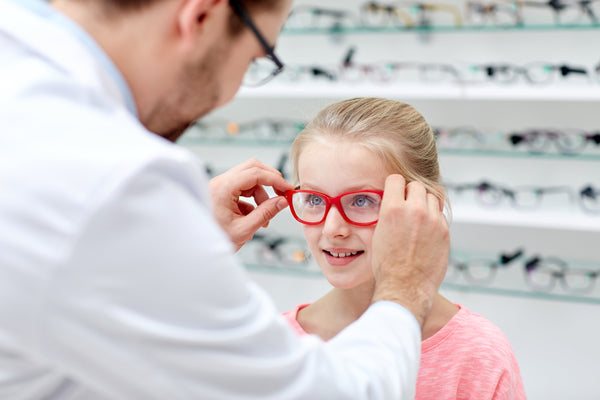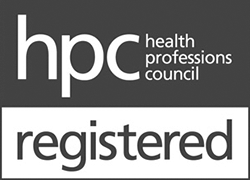
When examining your eyes, your optometrist will use a wide variety of tests and procedures to assess the health of your eyes and test your eyesight. These tests range from the typical eye chart test to more complex exams, such as using a high-powered lens to view the tiny structures inside your eye.
Having your eyes tested regularly is important, especially if you have a history of eye disease in your family, you work with screens, or if you already wear glasses.
Read on to learn more about the different types of eye tests and what they are for.
What Is an Eye Test?
An eye exam is not just one test but is actually a group of tests your optometrist performs to examine the health of your eyes. They don’t just test your eyesight. An in-depth eye test can be an important preventative step to catching more serious eye and vision conditions, such as cataracts before they get worse.
Vision tests are just some of the basic components of an eye exam. During a typical eye exam, you'll also discuss any recent vision changes you may have noticed, and your optometrist might run other tests to look at things like the backs of your eyes, and your overall eye health.

Leighton's Eye Tests
When you book an eye test at Leightons, you can look forward to a comprehensive eye exam that’s perfectly tailored to you. Using the very latest technology, we’ll take the time to understand your needs and build a complete picture of your eye health.
Book your eye test with us.
The Ultimate Eye Examination
The Ultimate Eye Examination combines pioneering technology with clinical excellence to capture 2D and 3D pictures of your eyes, using Optomap and OCT in an enhanced imaging package. It is highly recommended to our patients of all ages.
-Optomap (Scanning Laser Ophthalmoscopy) allows us to take an incredibly detailed image of your retina (the back of the eye) and shows up to 80% of the surface in one ultra-wide panoramic view.
-OCT (Optical Coherence Tomography) takes a scan of the layers beneath the central retina, giving a cross-section image that helps the optometrist build a complete picture of your eye health.
Taking images during the Ultimate Eye Examination is quick and painless – it only takes a few moments and nothing touches your eyes. Both these images are able to reveal details that are either impossible or very difficult to see with traditional examination techniques and play an important role in both ocular health monitoring and disease detection.
The Oct Eye Examination
With certain eye conditions, the faster you act, the more you protect. Optical Coherence Tomography (OCT) works a little like ultrasound for the eye. It shows us beyond the retinal surface and gives a cross-section view of the layers of tissue behind, helping us to spot abnormalities up to five years before a traditional test.
It can spot early signs of: -Macula conditions including Age-related Macular Degeneration (AMD) -Glaucoma -Diabetes - by detecting Diabetic Retinopathy
It’s not just for those whose vision has changed or who have a history of conditions like glaucoma, the Leightons OCT Eye Examination is recommended for all our adult patients. If you’re already under the care of an eye specialist, this can be a fantastic way to help co-monitor your eye condition.

Retinal Photography
Retinal Photography comes as a standard part of the Ultimate Leightons Eye Examination package. This is a process where a special camera takes a digital image of the back of the eye. This is so your optometrist can examine parts of the retina in a way not possible with conventional instruments.
Retinal cameras help the early detection of problems such as macular degeneration, glaucoma, retinal detachments and diabetic retinopathy.
Visual Stress & Colorimetry
"Visual Stress" is where processing of text is atypical. This can lead to difficulties reading, headaches, and other visual problems when reading text. It is not the same as dyslexia, although the two conditions commonly occur together.
During a visual stress examination, we try a number of acetate plastic sheets in various colours to determine whether colour will help reduce the discomfort experienced. There are then two options to help you going forward – coloured acetate overlays or tinted glasses. Acetate overlays are cheap and easy to use – simply place the piece of acetate over your screen or whatever you’re trying to read. Tinted glasses are a convenient alternative to an acetate sheet and achieve the same results.

Dry Eye Assessment
Dry eyes are a very common condition. They’re caused by problems with your tear production, and even watery eyes can be considered dry if your tears are not lubricating your eyes properly.
A Dry Eye Assessment is a specialised eye examination to investigate dry eye symptoms. During a dry eye assessment we carefully discuss your concerns and carry out a detailed observation of your eyes. We will use a microscope to look at the surface of the eyes and tear fluid at high magnifications. We will also put a very small amount of coloured liquid into the tears to assess how the tears flow, and see if there are any dry areas on the surface of the eyes. This does not hurt, sting or change your vision in any way but well worth booking in if you experience itchy, gritty, red, sore, or excessively watery eyes.
12 General Types of Eye Tests
1. Visual Acuity Test
The most common eye test you probably imagine. Visual acuity tests measure the sharpness of your vision.
These are usually performed using a projected eye chart to measure your ability to discern fine detail at distance and near (visual acuity).
2. Refraction Test
This is the test that your optometrist uses to determine your exact glasses prescription. The optometrist will ask you to wear an instrument called a trial frame, or look through an instrument called a phoropter and show you a series of lens choices. They will then ask you which of the two lenses in each choice looks clearer.
Based on your answers, they will continue to fine-tune the lens until they reach a final glasses prescription.
The refraction determines your level of hyperopia (long sightedness), myopia (short sightedness), astigmatism and presbyopia.

3. Slit-lamp Examination
A slit lamp test is performed with a biomicroscope that your optometrist uses to examine the structures of your eye under high magnification. It looks a bit like a large, upright microscope.
During a slit lamp exam, you will be asked to place your forehead and chin securely against the supports while your optometrist examines the structures of the front of your eyes — including your eyelids, cornea, conjunctiva, iris, and lens. Your optometrist may also use the slit lamp to examine structures located further back in the eye, including the retina and optic nerve.
Eye conditions such as cataracts, macular degeneration, corneal ulcers and diabetic retinopathy can all be detected with a slit lamp exam.
4. Tonometry markdown
Tonometry measures the amount of pressure it takes to flatten a portion of your cornea which is an important measure for assessing your risk for conditions such as glaucoma, or if you have this condition, keeping track of treatment.
This test can be done a number of ways, most frequently this is done using a puff of air, but on occasion it may be done with a special tool called a tonometer, that requires special numbing drops in your eye.Your optometrist will give you drops to numb your eye, before gently pressing on it with a tool called a tonometer to take a reading.
5. Retinal Examination (ophthalmoscopy)
Ophthalmoscopy, also known as a Fundoscopic exam, is an examination of the back part of the eye (fundus), including the retina, optic disc, choroid, and blood vessels. There are several different ways this can be undertaken, using a slit lamp and special lens to look into the eye, a hand held device known as an ophthalmoscope or even a headset mounted imaging device.
6. Visual Field Test
This test measures your peripheral (side) vision. It will require you to stare at an object in the centre of your line of vision (such as the optometrist’s finger or pen). As you look at the item, you’ll be asked to note when you see another object moving into your field of vision. This test lets the doctor know if conditions like stroke or glaucoma have affected your vision.
7. Colour Vision Test
This test screens for colour blindness by examining your ability to distinguish colours. You may be asked to look at images with letters or numbers hidden inside to determine your level of colour blindness. Colour blindness tests can help detect hereditary colour vision deficiencies as well as possible eye health conditions that may affect vision.
8. Autorefraction
An autorefraction test is also used to test your glasses prescription. An autorefractor is a machine you look into – usually to look at a pinpoint of light or small image – and the machine automatically works out your prescription. They’re very accurate and much faster than traditional testing, however the results are not always as reliable as traditional eye tests.

9. Eye Movement Testing
Eye movement testing is carried out to assess how well your eyes move and coordinate. These tests can help to provide insights into the functioning of the muscles that control eye movements and coordination. They are used to detect issues such as strabismus (crossed or misaligned eyes), amblyopia (lazy eye), and nystagmus (involuntary eye movements).
The most common type of eye movement testing is a Cover Test, which is performed to determine how your eyes work together. During one of these tests, your optometrist will ask you to focus on a small object across the room. They will then cover each of your eyes alternately while you stare at the target. The test is repeated with you looking at a nearer object.
Your optometrist will assess whether your uncovered eye needs to move to focus on each target. The results from this test can be used to adjust glasses prescriptions accordingly to better suit the wearer.
Whilst the Cover Test is the most common, other tests are used depending on the equipment within each practice. Each test can help understand how your eyes are able to move in different ways, which are important for carrying out specific day to day tasks such as reading, driving, sports and much more.
10. Amsler Grid Test markdown
The Amsler grid eye test helps you see vision distortions (metamorphopsia) that can happen if you have certain conditions affecting your macula (part of the retina at the back of the eye). You can perform this test at home or with an optometrist and it can help identify where the distortions are in your visual field.
11. Keratometry
Keratometry measures the curvature of the cornea. It is used to determine the corneal refractive power and is an important consideration when measuring before eye surgery. The information is also used when measuring you for contact lenses.

12. Pupil Dilation
To get a better view of your eye's internal structures such as the retina and optic nerve, your optometrist may recommend a pupil dilation test. They will administer dilating drops to enlarge your pupils which take about 20 to 30 minutes to start working. This will allow your optometrist to take a more thorough look at the inside of your eye. Importantly OPTOMAP retinal photography (see above) can potentially negate the need for pupil dilation so we only resort to this examination technique when absolutely necessary.
It’s recommended to bring sunglasses to your dilation appointment as your eyes will be very sensitive to light once the exam is complete.
Additionally drops will blur patient's vision for around 4-6 hours after administration so patients shouldn't drive/operate heavy machinery after this test.
Why choose Leightons?
We have been providing our customers with top-notch eye care services since 1928. We are a family-owned, family-run business so you know you’re in the best hands. Not only that, but we use the latest technology, imaging tools, and up-to-date equipment to ensure we take the best care of your eyes as possible.
Final Thoughts
Keeping on top of your eye health is vital.. By scheduling regular check-ups and eye exams, you can keep on top of your eye health as well as catch issues before they develop. If you notice a change in your vision or have any concerns about your eyesight, don’t hesitate to seek professional help.
Book your eye test appointment with Leightons today.








